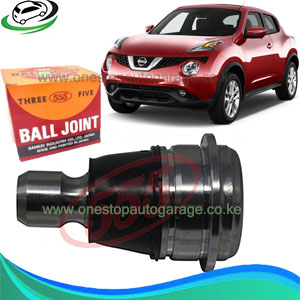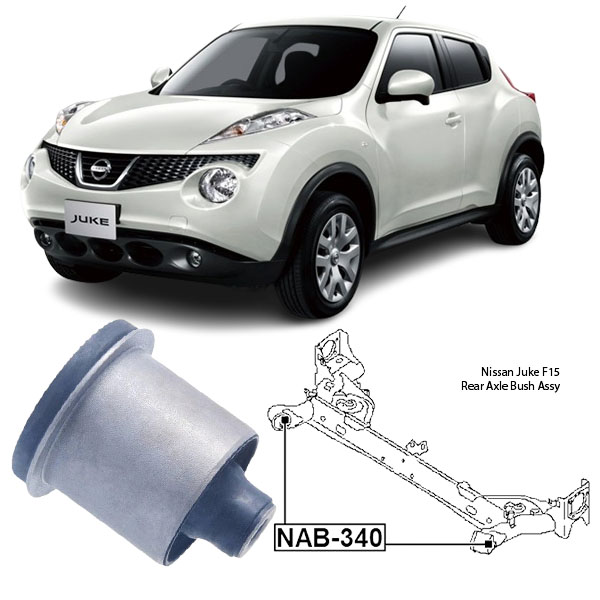-17%
Get Nissan Juke F15 Rear Axle Arm Bush NAB-340 in Kenya
The rear axle arm bush, commonly referred to as a rear trailing arm bush or rear suspension bushing, is a crucial component in a vehicle’s suspension system. Though small, it plays a significant role in ensuring stability, comfort, and proper wheel alignment. In this detailed explanation, we will explore its function, benefits, signs of wear, maintenance tips, and replacement considerations.
1. Understanding the Rear Axle Arm Bush
What is a Rear Axle Arm Bush?
A rear axle arm bush is a cylindrical rubber or polyurethane component fitted between the rear trailing arm and the vehicle’s chassis. It acts as a damping element, absorbing vibrations, reducing noise, and preventing excessive metal-to-metal contact.
In most vehicles, the rear axle arm bush is housed within a metal casing or bracket, and it allows limited movement of the suspension arm. This movement is necessary for flexibility and shock absorption when driving over uneven terrain.
Location in the Vehicle
The rear axle arm bush is located in the rear suspension system, connecting the trailing arm (which holds the rear wheels) to the vehicle’s chassis or subframe. It is often pressed into a metal bracket to provide stability.
Material Composition
- Rubber: Common in OEM (original equipment manufacturer) bushings for flexibility and smooth ride quality.
- Polyurethane (PU): Used in aftermarket bushings for enhanced durability and firmer suspension feel.
- Metal Inserts: Provide structural support and reduce deformation under load.
2. Functions of the Rear Axle Arm Bush
A. Suspension Flexibility and Control
The rear axle arm bush allows controlled movement of the rear suspension, helping to maintain proper alignment and comfort. Without it, the trailing arm would transfer excessive force directly to the chassis, causing discomfort and instability.
B. Vibration and Noise Reduction
As part of the suspension system, the bush absorbs road vibrations, preventing them from being transmitted to the vehicle cabin. This significantly improves ride quality and reduces noise from bumps and road imperfections.
C. Maintaining Rear Wheel Alignment
The rear axle arm bush helps in keeping the rear wheels properly aligned with the chassis, ensuring even tire wear and optimal vehicle handling. Worn bushings can lead to misalignment, affecting tire lifespan and driving stability.
D. Impact Absorption
When driving over potholes or speed bumps, the rear axle arm bush absorbs a significant portion of the impact, protecting the suspension components from excessive stress.
E. Enhancing Vehicle Stability and Safety
A well-maintained rear axle arm bush helps keep the vehicle stable, especially when cornering or braking, preventing excessive lateral movement of the rear axle.
3. Benefits of a Properly Functioning Rear Axle Arm Bush
A. Smoother Ride Quality
By reducing vibrations and impacts, the rear axle arm bush significantly improves ride comfort, ensuring a smoother driving experience.
B. Improved Handling and Stability
A stiff and intact bush provides better vehicle control by reducing excessive body roll and enhancing steering precision.
C. Reduced Tire and Suspension Wear
A properly functioning rear axle arm bush ensures the rear suspension works efficiently, reducing unnecessary stress on tires, shock absorbers, and other suspension components.
D. Enhanced Longevity of Suspension Components
Since the bush absorbs shocks and minimizes direct metal-to-metal contact, it prolongs the life of other suspension parts, reducing maintenance costs.
E. Better Braking Performance
A stable suspension setup improves braking efficiency, preventing instability when decelerating or making sudden stops.
4. Signs of a Worn or Failing Rear Axle Arm Bush
Over time, the rubber in the bush deteriorates due to constant flexing, exposure to heat, road debris, and chemicals like oil and salt. Here are some signs that indicate wear or failure:
A. Clunking or Knocking Noises
A worn or damaged bush may allow excessive movement of the rear suspension arm, causing metal-to-metal contact that results in clunking sounds when going over bumps.
B. Rear Wheel Misalignment
If the rear axle arm bush is excessively worn, it can cause misalignment of the rear wheels, leading to uneven tire wear and unstable handling.
C. Excessive Vibrations in the Cabin
A failing bush loses its ability to dampen road vibrations, resulting in increased discomfort inside the vehicle.
D. Increased Tire Wear
Uneven or rapid tire wear, especially on the inner or outer edges, can be a symptom of excessive movement in the rear suspension.
E. Poor Handling and Stability Issues
If the vehicle feels unstable when cornering or braking, it could be due to excessive play in the rear axle arm bush.
F. Visible Cracks or Deterioration
A simple visual inspection may reveal cracks, tears, or deformation in the rubber of the bush, indicating the need for replacement.
5. Maintenance and Replacement Tips
A. Regular Inspections
- Inspect the rear axle arm bush every 30,000 to 50,000 km (or as recommended by the manufacturer).
- Look for visible wear, cracks, or excessive movement in the bush.
B. Driving Habits Matter
- Avoid aggressive driving, heavy loads, and rough terrains to extend the lifespan of the bush.
- Slow down over speed bumps and potholes to reduce stress on the rear suspension.
C. Choosing the Right Replacement Bush
When replacing the rear axle arm bush, consider:
- OEM Rubber Bushes: If you prefer comfort and a factory-like ride.
- Polyurethane Bushes: If you need longer durability and better performance but don’t mind a firmer ride.
D. DIY vs. Professional Replacement
- Replacing the rear axle arm bush requires special tools (like a hydraulic press) and mechanical expertise.
- If improperly installed, it can cause suspension misalignment and uneven wear.
- It’s advisable to have a professional mechanic handle the replacement.
E. Replace in Pairs
Just like shock absorbers, always replace rear axle arm bushes in pairs to maintain balanced suspension performance.
F. Lubrication and Protection
- Use protective sprays to prevent excessive wear due to dirt and moisture exposure.
- If using polyurethane bushes, apply silicone-based lubricants to prevent squeaking.
6. Conclusion
The rear axle arm bush is a small yet essential component in the suspension system, contributing to vehicle stability, comfort, and handling. Regular inspection and timely replacement can prevent issues like clunking noises, poor alignment, and excessive vibrations.
Choosing the right material (rubber vs. polyurethane) depends on your driving needs, but ensuring a professional installation guarantees optimal performance and longevity.
Follow us on Facebook for more parts.



